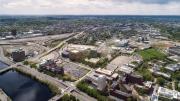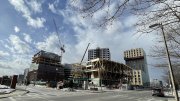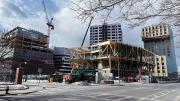Boston regulators have finally approved the first, 9.4-acre phase of the “enterprise research campus” (ERC) in Allston, a largely commercial project being advanced by Harvard development partner Tishman Speyer. The Boston Planning and Development Agency’s (BPDA) board of directors approved the plan for this Phase A in a meeting on the evening of July 14. The project will include retail, residential, laboratory, and office space, as well as a hotel and University-operated conference center—in all, 900,000 square feet of new development in this first phase—on a portion of 14 acres of land leased from Harvard.
An extended public review process led to a hashing out of the last major stumbling blocks in the second week of July, centered on two main issues: housing affordability, and funding for an enhanced community planning process. These two concerns rose to prominence during extensive engagement with the community and elected officials, including Boston’s new mayor, Michelle Wu ’07, J.D. ’12, who highlighted the housing affordability crisis during her campaign for election. The plan approved last night incorporates an unprecedented commitment to affordable housing by both Tishman Speyer and Harvard in the Allston-Brighton neighborhood.
The baseline for these negotiations was laid in February, when former Harvard executive vice president Katie Lapp wrote to Wu, outlining a series of commitments that the University was willing to make concerning planning, community engagement, open space, affordable housing, workforce development, and infrastructure improvements for its commercial developments. Among these numerous commitments, Lapp pledged to:
- ensure that 20 percent of the housing units in the ERC (which will ultimately encompass 14 acres of a larger 36-acre innovation district) would be income-restricted; and
- provide up to $10 million over five years for affordable-housing creation and preservation.
Then, at a June 30 public meeting of the Harvard Allston Task Force (an advisory body to the BPDA), Tishman Speyer inched closer to an agreement by offering to designate in the first phase 25 percent of the residential units affordable (with eligibility restricted to those whose incomes are 50 to 100 percent of the area-median income)—nearly double the City of Boston mandate of 13 percent, and 5 percent more affordable units than had been stipulated previously.
At the same June meeting, Harvard offered among other commitments to:
- participate in an Allston-Brighton community needs assessment to help inform future community benefits priorities, and to provide funding up to $1 million;
- place a 99-year development restriction on the 1.4-acre greenway in Phase A; and
- provide $20 million over 10 years for affordable housing in Allston.
That brought the community, elected officials, Harvard, and Tishman Speyer tantalizingly close to agreement. But the community, which had earlier expressed its desire that some of the affordable units in the project be deeply discounted (with eligibility restricted on some units to as low as 30 percent of area median income [AMI]), pressed for this concession. Tishman Speyer had previously indicated its willingness to do so, but noted that this would affect the overall mix of units offered at different percentages of AMI. As part of the final agreement, presented to the BPDA’s board for approval, the 86 affordable units (of 345 total residential units) will be offered at AMI levels ranging from 30 to 100 percent: a more inclusive standard than the prior proposal of 50 to 100 percent.
Harvard, for its part, offered in the final, approved agreement, to increase its support for affordable housing in Allston from $20 million over 10 years to $25 million over 12 years, keeping the rate of its investment in this issue steady for a longer period of time.
Harvard Allston Task Force member Edward Kotomori singled out Tishman Speyer’s willingness to offer some affordable units at 30 percent of AMI. “Do you know what that means?” he asked. “It means that people who are poor are going to be allowed” to live there. “I hope other developers take a hint,” he added, “and follow Tishman’s example.”
Among those who spoke at the meeting was task force member Barbara Parmenter, who thanked elected and appointed officials who had helped broker the deal. But while expressing support for the project, she also highlighted what she called “the broken planning process that then-Councillor Wu [now Mayor Wu] spoke about in her report on the BPDA several years ago.” And her praise for “Harvard’s commitment to a comprehensive planning process” was balanced by a criticism: “I feel like we could have been at this point six months ago, had Harvard listened more constructively to the task force. Looking forward, I ask Harvard to commit to more open, honest, and respectful dialogue: no more sales pitches, no more marketing presentations, no more well-rehearsed talking points, repeated in response to our questions. We are in a housing crisis, a transportation crisis, and a climate crisis. The redevelopment of our neighborhood can help address all of these and could be good for all of us—if we have honest, frank and productive conversations.”
Neighborhood activist Eva Webster of Brighton, however, offered a different perspective in response to the comment that “this all could have been done six months ago if Harvard was more reasonable.” “I happen to think,” she countered, “that it could have been done sooner and with less drama, if some people in the community were more reasonable.” Noting that there are pros and cons to the presence of large educational institutions in the Allston-Brighton community, she urged a more “balanced approach when we negotiate with Harvard and B[oston] C[ollege] and B[oston] U[niversity]” so as not to turn it into “a tug of war….” Addressing the affordable housing crisis, she continued, “everyone understands that people who cannot find well-paying jobs have to live somewhere, and it’s up to the city to make sure that they are not homeless. But we also have to remember that every single residential project is built with market-rate materials. And of course, in Boston, we are requiring union labor. So it’s very expensive to develop housing.” Demanding “50 percent, 60 percent affordable housing is simply unrealistic. I’m just happy that we are making some progress, because keeping all this land undeveloped would be a waste of opportunity.”
Former Harvard Allston Task Force member John Bruno, who noted that he has also worked with Boston University and Boston College on their development plans over the years, and helped create some of the public review framework used by the BPDA, expressed enthusiastic support for the project. “The proponent has exceeded expectations,” he said, noting that the project would revitalize an underutilized area of North Allston “blighted for decades” and “create nearly double the housing component, going from the required 13 percent, to an unheard of 25 percent affordability…” while creating “a lucrative tax base for the city of Boston.”
Arthur Jemison, appointed the first chief of planning for the City of Boston by Mayor Wu in April, and named director of the BPDA in May, noted that the board had approved four new development projects during the course of the hours-long BPDA director’s meeting: 388 new residential units, including 94 income-restricted units—86 of them as part of Tishman Speyer’s ERC project—with a total estimated cost of around $1.5 billion. “These projects” said the former Principal Deputy Assistant Secretary of Housing and Urban Development of the Biden administration, “will develop about 1.7 million square feet and when constructed, they’ll put 1,700 tradespeople to work. Thirty-six hundred direct jobs will be created, and 938 indirect jobs.” Jemison also said that “Kudos are due to Harvard, Tishman Speyer, all of their vendors and contractors, and the equity investors,” noting that they will include black and LatinX partners “new to this process” as part of Harvard and Tishman Speyer’s inclusionary commitments. He also thanked all the officials and staff involved in bringing the project forward, including notably, “Mayor Wu for creating the convening effect that caused a lot of this discussion to reach the threshold that it has.”
With the approval in hand and site preparation under way, Tishman Speyer could begin significant construction soon, with initial occupancy beginning in 2024 or early 2025.








